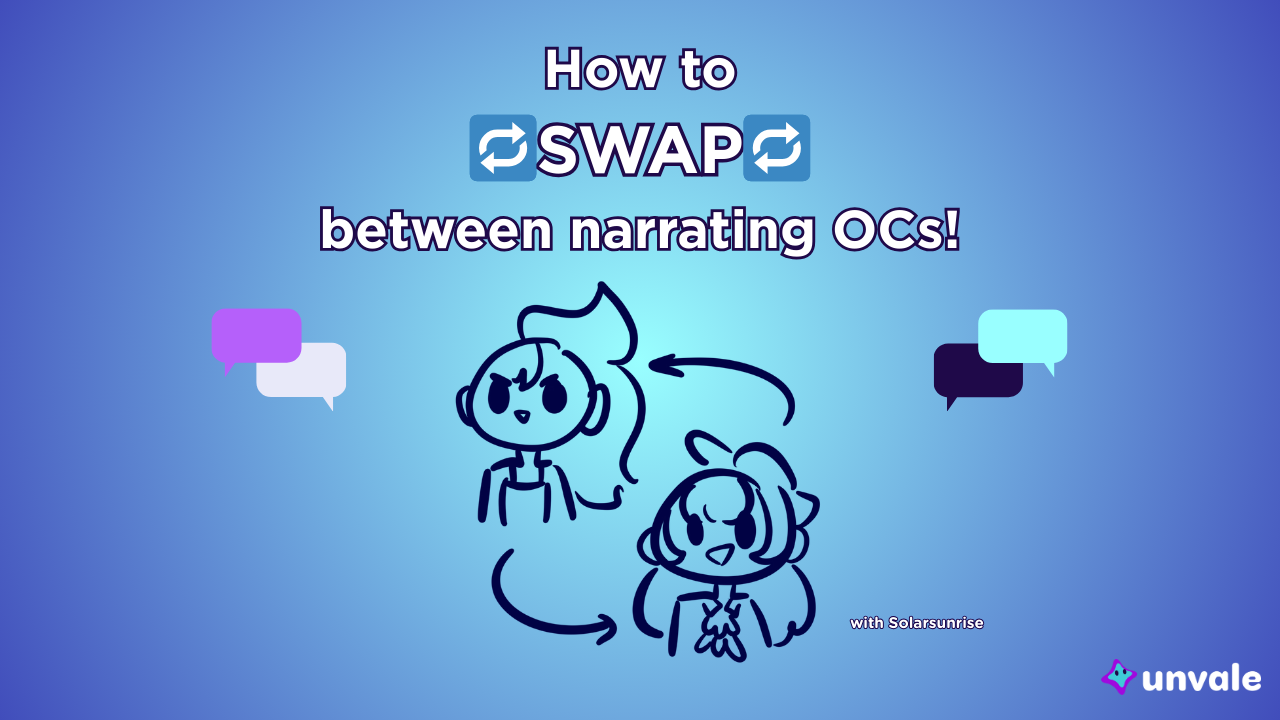How to Swap Between Narrating OCs

Have you ever found yourself reading something where the narration suddenly shifts to a different character entirely, and it takes you a good minute to figure out what happened? Or maybe you’ve seen a character’s name as the transition sign in the middle of a chapter and it throws you off, bringing you out of immersion? Well, this article aims to help you avoid that in your own writing. We’ll be covering some more complex writing subjects, but don’t worry! It’s easier than it might seem.
Skip past the lessons to the end if you just want the advice and aren’t here for a quick lesson in writing narration!
In the English language, there are three main ‘points of view’ that we write in. They are first-person, second-person, and third-person. They’re surprisingly easy to remember with my secret trick, so let’s explain them first.
First-Person Narration
You might be familiar with the video game term ‘FPS’ or first-person shooter, a style of combat game where you, the player, see out of the character’s eyes. First-person narration style is the same; the reader is in the role of the narrating character.
“I kicked the ball. I walked the dog. I saw her from across the room.”
Third-Person Narration
Third-person perspective is the perspective when you watch a play, TV, or play certain games like Mario. You are watching the character from an outside perspective. It’s commonly used in all sorts of written media.
“Solar kicked the ball. She walked the dog. Solar saw her from across the room.”
Second-Person Narration
Points to you if you know this one! It’s rarely used in writing or media, but when it is used, it tends to be to great effect. Second-person refers to ‘you’. Yes you. The one reading the article right now. You’re reading these words right now on a screen! Are you shocked that your actions are being narrated through second-person?
“You kicked the ball. You walked the dog. You saw her from across the room.”
Now, the trick for easily remembering which is which.
“I was the first person in the room. You are the second. They entered third.”
If I’m alone, then I’m the first person. If you’re here, you’re the second person. And the third person over there, is them. Hopefully this trick works for you!
“Eugh, more tenses?” Yes, more tenses. But these ones are just as important, and much simpler too.
Like first and third-person narration, past and present tense are the most commonly used in written media. Future tense is rarely used in narration, much like second-person narration (meaning if you really want to flex your writing skills, try writing in second-person future tense. ‘You will find it helps you explore new writing styles’, perhaps! And yes, that was an example of the narration style).
As a quick summary, past tense uses language that refers to past actions. All the examples from the prior section were in past tense. If I was to write them in present tense though, aka currently happening…
“I’m kicking the ball. I’m walking the dog. I can see her from across the room.”
Similarly, future tense refers to things that will happen in the future.
The quickest, easiest way to make swapping between OC narration is through omniscient narration. It’s almost always done in third-person, making swapping between characters a breeze. The narrator knows what’s happening in each character’s head, or what’s happening in other places and scenes. They are not usually a part of the story themselves, acting as a ‘narrative device’; just another tool for the author to use.
When writing in first-person though, you’re usually firmly in your character’s head. Your character doesn’t know that the evil witch of nightmares, Phobos, is plotting to unleash a monster made out of what you fished up from your shower drain the other day. They don’t know that the big bad villain is secretly their long lost father. But maybe the audience does, if you write your story in a way that allows them to guess without giving your point of view (POV) character the actual answer. This is called limited narration.
Suddenly swapping to another kind of POV is jarring, and can lead your reader to wonder how the narrator learned something they shouldn’t know. So, how do we fix that?
Lesson’s Over! How to Swap POV Between Narrating OCs
(I’ll be using terms from above freely, so remember to reference if you get confused!) Now, I’ll recommend specific methods you can use here for simplicity’s sake.
Option 1:
Say you have two main narrating characters. Is there one that’s more of the focus than the other? In that case, you can use first-person limited for our protagonist, and third-person limited for our deuteragonist (a fancy term for secondary protagonist). The tense you use here doesn’t matter exactly, but it’s good for them to match unless you want to communicate that one narration is happening in the past, and the other in the future. That’s an interesting concept to play with though!
Option 1.5:
Maybe you have a protagonist and numerous supporting characters who get their own time in the spotlight. In that case, you can always try swapping from first-person limited to third-person omniscient (or limited) when needed. It becomes obviously clear that you’ve swapped perspectives since you’re not using “I” anymore. This works for things such as flashbacks, especially if you swap from present to past tense like I mentioned above.
Option 2:
Third-person omniscient narration never goes wrong. However, you have to start each section by properly introducing the character or location that the narrator’s following now. It’s not really a difficult task, but it’s good to make sure you clearly show who’s thinking or saying what to avoid confusion. Stating that a character doesn’t know something is never a bad thing, but you can always show it as well!
Option 3:
Meanwhile, third-person limited is much like above, but the knowledge shared to the reader is limited to what the POV character can sense and know. Swapping to another POV character is simpler here.
Closing Tips
- If you can separate POV swaps into different chapters, it’s good to do so. This clearly marks any POV shifts and creates a chance for your reader to adjust to a new narrator.
- Using a specific style of speech or specific thought patterns can make your narrating characters seriously standout. For instance, my character Lilia is a photographer, so her narration would notice photography opportunities and her interest in medicine would have her noticing medicinal plants in the area. Meanwhile, a character like Bea has a disability that affects how she perceives the world; being half-deaf changes the way she reacts to her environment. Think about what makes your characters unique in how they perceive the world.
- Remember, when writing for fun, don’t take anything here too seriously! Not everything needs to be perfectly polished to share, and you don’t need to be a writer with lots of experience to be worthy of reading. Take a look and compliment the works of other writers on Unvale next chance you get!
- Here’s a fun tip to make swapping POVs easier without needing to sweat the hard stuff. Use three emojis at the start of each transition to represent who’s POV it is, and list the POVs in the writing piece’s description. (Why three? It’s a reference to a method of communicating scene breaks in writing.
Wow! That’s a lot of writing, and a lot of reading. Maybe you’ve learned something, or maybe this’ something you already knew; a refresher never hurts! Great work reading through either way! Now, get to writing! If you have any questions about writing or how to do certain things, never feel shy about asking other writers; myself included! And who knows, maybe you’ll get more writing advice like this in the future~!

